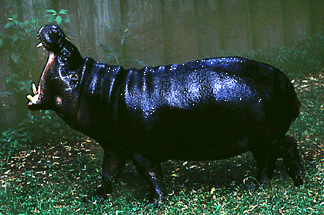PYGMY HIPPOPOTAMUS
Choeropsis liberiensis
MAMMAL
Order Artiodactyla
Description
4.5-6 ft long, tail 6 in; 825-585 lbs. Body hairless except for bristles on lips and tail. Slate greenish-black above with gray sides and lighter underparts. Toes separate with sharp nails.
Range
western Africa: Ivory Coast, Liberia and Sierra Leone.
Status
Although not currently listed as endangered,
commercial trade of
this species is regulated by international law, since it may become endangered
without regulated trade. The tusks are prized for the high quality of their
ivory.

 Ecology
Ecology
- Habitat
- wet forest, streams and swamps
- Niche
- herbivorous: prefers fallen fruit, aquatic shoots and leaves. Makes deep, tunnel-like paths through dense brush to the water. Less sociable and aquatic than big hippos; found singly or in pairs. Runs into forest instead of water when in danger. Hunted by natives as a food source.
Life History
Gestation about 7 mo; 6-11 lbs at birth; usually single young are born. Life span up to 42 yrs in captivity.
Special Adaptations
- Lower canine teeth modified as tusks which servo as weapons and, with the lips, help to crop vegetation.
- Body pores secrete a clear mucus that makes the animal slick to the touch and decreases resistance when swimming while protecting the skin.
- Eyes, nostrils and ears are designed so that they are above the water line when the animals body is submerged, enabling it to see, breathe and hear while concealed.
- Nostrils close when animal submerges completely.
